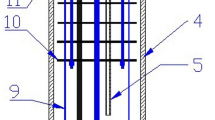Abstract
Development of an energy-efficient method for aluminum manufacturing is the current research trend in the aluminum electrolysis industry. A low-temperature electrolysis process is an appropriate choice for aluminum electrolysis. The NaF-KF-LiF-AlF3 system with its low cryolite ratio may be a suitable candidate electrolyte system because of its reduced liquidus temperature. In this paper, the liquidus temperature of NaF-KF-LiF-AlF3 system with cryolite ratios of 1.3 and 1.4 is investigated via the cooling curve method and the differential thermal analysis method. The effects of both potassium fluoride and lithium fluoride on the NaF-KF-LiF-AlF3 system are studied. The liquidus curves of systems containing potassium fluoride and lithium fluoride are different and depend on the KF/(NaF+KF+LiF) and LiF/(NaF+KF+LiF) ratios. Part of the (NaF-LiF-AlF3)-KF pseudo-binary phase diagram with fixed LiF concentration is plotted according to the data of liquidus temperature and the compositions of the phase diagram containing potassium fluoride and lithium fluoride with a cryolite ratio of 1.3 are analyzed. The change trend of the compositions is similar to the NaF-KF-AlF3 system with a low cryolite ratio. LiF hardly participate in the formation of the compounds at equilibrium state except for the fact that chiolite is the main composition of molten salt.









Similar content being viewed by others
References
H. Kvande and Drabløs. P . A, Journal of occupational and environmental medicine, 2014, vol. 56, pp. S23-S32.
A. Sterten, S. Rolseth and E. Skybakmoen: Light Metals, TMS, Warrendale, 1988, pp. 663.
N. X. Feng. Aluminum Electrolysis, Chemical Industry Press, Beijing,, 2006, pp. 21.
P. Fellner, S. Midtlyng, A. Sterten, J. Thonstad: Journal of applied electrochemistry, 1993, vol. 23, pp. 78-81.
A. Redkin, A .Apisarov, A .Dedyukhin, V. Kovrov: ECS Transactions, 2013, vol. 50, pp. 205-213.
J. Yang, D.G. Graczyk, C. Wunsch, J. N. Hryn: Light Metals, TMS, Warrendale, 2007, pp. 537-541.
A. Apisarov, A. Dedyukhin, E. Nikolaeva, P. Tinghaev, O. Tkacheva, A. Redkin and Y. Zaikov: Metallurgical and Materials Transactions B, 2011, vol. 42, pp. 236-242.
H. Yan, J .Yang, W. Li and S. Z. Chen: Metallurgical and materials Transactions B, 2011, vol. 42, pp. 1065-1070.
J. P. Peng, Y. Z. Di, Y. W. Wang, Y. B. Bai, N. X. Feng: Journal of Mining & Metallurgy. Section B: Metallurgy, 2014, vol. 50, pp. 23-26.
X. Lv, Y. Shuang, J. Li, S. Y. Chen, Y. Q. Lai, H. L. Zhang and Y. X. Liu: Metallurgical and Materials Transactions B, 2017, vol. 48, pp. 1315-1320.
Y. G. Huang, Z .L .Tian, Y. Q. Lai, J. Li and Y. X. Liu: The Chinese Journal of Nonferrous Metals, 2010, vol. 5, pp. 903-906.
V. Danielik: Chemical papers, 2005, vol. 59 pp. 81-84.
J. Híveš, Å. Thonstad, P. Sterten: Light Metals, TMS, Warrendale, 1994, pp. 187-194.
J. Gabèová, M. Marko and P. Fellner: Chem. Papers, 1995, vol. 49, pp. 13.
P. Cui, B. Qin, G. M. Haarberg: Journal of The Electrochemical Society, 2019, vol. 166, pp. D559-D563.
B. Kubikova, J. Mlynáriková, M. Boča, Z. N. Shi, B. L.GaO, N. Petel: Journal of Chemical & Engineering Data, 2018, vol. 63, pp. 3047-3052.
Z. Wei, J. Peng, Y. Wang, K. J. Liu, Y. Z. Di, T. Sun: Ionics, 2019, vol. 25, pp. 1735-1745.
J. Peng, Z. Wei, Y. Z. Di, Y. Wang, and T. Sun.: JOM 72:239-246 (2019).
Z. Vasková, M. Kontrík, J. Mlynáriková and M. Boca: Metallurgical and Materials Transactions B, 2015, vol. 46, pp. 485-493.
D.F. Craig and J. J. Brown: J. Am. Ceram. Soc., 1980, vol. 63, pp. 254–261.
A. S. Samoilo, Y. N. Zaitseva, P. S. Dubinin, O. E. Piksina, S. G. Ruzhnikov, I. S. Yakimov and S.D. Kirik: Journal of Solid State Chemistry, 2017, vol. 252, pp. 1-7.
E. W. Dewing, Proceedings of the 5th International Symposium on Molten Salts, The Electrochemical Society Inc, Pennington, 1986, pp. 262.
Acknowledgments
We acknowledge the support received from the National Natural Science Foundation of China (Grant Nos. 51774080 and 51434005) and National Key R&D Program of China (2018YFC1901905) and Fundamental research funds for the central universities (No. 162502002).
Author information
Authors and Affiliations
Corresponding author
Additional information
Publisher's Note
Springer Nature remains neutral with regard to jurisdictional claims in published maps and institutional affiliations.
Manuscript submitted October 31, 2019.
Rights and permissions
About this article
Cite this article
Chen, B., Peng, J., Wang, Y. et al. Study on Liquidus Temperature of NaF-KF-LiF-AlF3 System with Low Cryolite Ratio. Metall Mater Trans B 51, 1181–1189 (2020). https://doi.org/10.1007/s11663-020-01800-4
Received:
Published:
Issue Date:
DOI: https://doi.org/10.1007/s11663-020-01800-4




